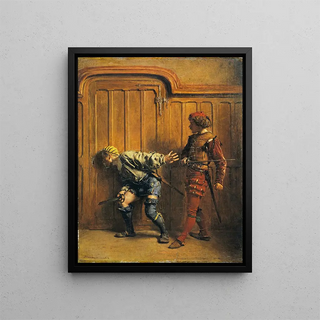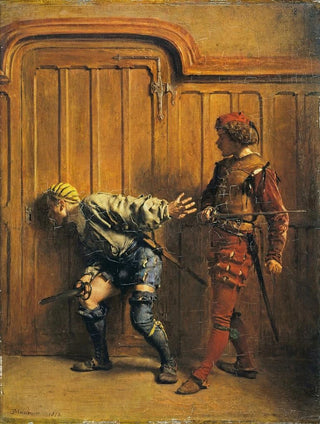Art print Les assassins à gages - Ernest Meissonier | Art print


View from behind

Frame (optional)
The artwork "Les assassins à gages" by Ernest Meissonier is a masterpiece that transports viewers into a universe where drama and tension intertwine with unparalleled technical mastery. Painted in the 19th century, this piece showcases the artist's skill in capturing emotionally charged moments while offering a reflection on human nature and the consequences of war. The scene depicts a group of mercenaries, frozen in a suspenseful instant, where each gaze and gesture seem to tell a story. The art print Les assassins à gages - Ernest Meissonier allows appreciation of this dynamic, while paying tribute to the narrative richness emanating from the original.
Style and uniqueness of the work
Meissonier's style is distinguished by striking realism and meticulous attention to detail. Every element of the composition, from the play of shadows to the texture of clothing, is carefully crafted, creating a palpable atmosphere. The characters, although frozen in a waiting posture, express a range of emotions that captivate the viewer and invite reflection on their motivations and thoughts. The color palette, subtly chosen, emphasizes the drama of the scene, while the skillfully manipulated light guides the eye toward the key elements of the work. This marriage of technique and storytelling makes "Les assassins à gages" a work of rare depth, where each gaze reveals a new facet of the story.
The artist and his influence
Ernest Meissonier, an emblematic figure of the realist movement, knew how to mark his era with his unique approach to historical and military painting. Trained in the studio of great masters, he developed a style that combines precision and expressiveness. Meissonier not only influenced his contemporaries but also left an indelible mark on modern painting. His interest in historical narratives and battle scenes reflects a passion for depicting man in the face of his destiny. By highlighting moments of tension and bravery, he contributed to redefining the standards of history painting, opening the

Matte finish

View from behind

Frame (optional)
The artwork "Les assassins à gages" by Ernest Meissonier is a masterpiece that transports viewers into a universe where drama and tension intertwine with unparalleled technical mastery. Painted in the 19th century, this piece showcases the artist's skill in capturing emotionally charged moments while offering a reflection on human nature and the consequences of war. The scene depicts a group of mercenaries, frozen in a suspenseful instant, where each gaze and gesture seem to tell a story. The art print Les assassins à gages - Ernest Meissonier allows appreciation of this dynamic, while paying tribute to the narrative richness emanating from the original.
Style and uniqueness of the work
Meissonier's style is distinguished by striking realism and meticulous attention to detail. Every element of the composition, from the play of shadows to the texture of clothing, is carefully crafted, creating a palpable atmosphere. The characters, although frozen in a waiting posture, express a range of emotions that captivate the viewer and invite reflection on their motivations and thoughts. The color palette, subtly chosen, emphasizes the drama of the scene, while the skillfully manipulated light guides the eye toward the key elements of the work. This marriage of technique and storytelling makes "Les assassins à gages" a work of rare depth, where each gaze reveals a new facet of the story.
The artist and his influence
Ernest Meissonier, an emblematic figure of the realist movement, knew how to mark his era with his unique approach to historical and military painting. Trained in the studio of great masters, he developed a style that combines precision and expressiveness. Meissonier not only influenced his contemporaries but also left an indelible mark on modern painting. His interest in historical narratives and battle scenes reflects a passion for depicting man in the face of his destiny. By highlighting moments of tension and bravery, he contributed to redefining the standards of history painting, opening the
12,34 €






